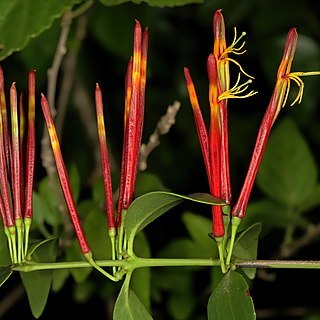Leaves opposite or alternate on long shoots, crowded and smaller at base of short shoots, then alternate, then opposite at tip; petiole 1–6 mm long; lamina dark green, thinly coriaceous, 8–45 × 3–15 mm, lanceolate to ovate-elliptic or oblanceolate, pointed to rounded at apex, cuneate at base, glabrous to minutely puberulous, with 2–6 pairs of lateral nerves, the lower ones ± strongly ascending.
Glabrous shrub, up to 1 m high, parasitic on species of various trees. Bud apex beaked to uncinate at maturity. Corolla tube not swollen at base, corolla base 1-2 mm wide. Style filiform. Flowers dark red withyellow band below apex.
Corolla 4.5–5 cm long, white, yellow or red, with an orange or yellow band below tip, glabrous, apiculate in bud, scarcely swollen at base; lobes erect, 13–16 mm long, upper three-quarters narrowly linear-oblanceolate.
Flowers 2–6 at ends of short lateral shoots, occasionally also in shortly pedunculate axillary umbels; pedicels 5–10(12) mm long; bract limb 1.5–2 mm long, ovate-triangular.
Shrub generally less than 1 m high, flowering on short shoots; branchlets slightly compressed at first, puberulous, glabrescent and soon greyish-brown corky.
Berry whitish turning red, 8–9 × 7–8 mm, obovoid-globose, verruculose; seed blue-green with pink top.
Stamen filaments slender, incurved; anthers 4–5 mm long.
Style filiform; stigma 0.6–0.8 mm across, capitate.
Receptacle 1.5–2 mm long, glabrous.
Calyx 0.5 mm long.

